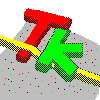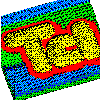Tcl 8.0 introduces the following incompatibilities that may affect Tcl
scripts that worked under Tcl 7.6 and earlier releases:
 Summary of changes in Tk 8.0
Summary of changes in Tk 8.0
Here is a list of the most important new features in Tk 8.0. The
release also includes several smaller feature changes and bug fixes.
See the "changes" file for a complete list of all changes.
- Native look and feel.
The widgets have been rewritten to provide
(nearly?) native look and feel on the Macintosh and PC. Many
widgets, including scrollbars, menus, and the button family, are
implemented with native platform widgets. Others, such as entries
and texts, have been modified to emulate native look and feel.
These changes are backwards compatible except that (a) some
configuration options are now ignored on some platforms and (b) you
must use the new menu mechanism described below to native look and
feel for menus.
- There is a new interface for creating menus, where a menubar is
implemented as a menu widget instead of a frame containing menubuttons.
The -menu option for a toplevel is used to specify the name of the
menubar; the menu will be displayed outside the toplevel using
different mechanisms on each platform (e.g. on the Macintosh the menu
will appear at the top of the screen). See the menu demos in the
widget demo for examples. The old style of menu still works, but
does not provide native look and feel. Menus have several new
features:
- New
"-columnbreak" and
"-hideMargin"
options make it possible to create multi-column menus.
- It is now possible to manipulate the Apple and Help menus on
the Macintosh, and the system menu on Windows. It is also
possible to have a right justified Help menu on Unix.
- Menus now issue the virtual event
<<MenuSelect>> whenever the
current item changes. Applications can use this to generate
help messages.
- There is a new
"-direction"
option for menubuttons, which
controls where the menu pops up revenues to the button.
- The font mechanism in Tk has been completely reworked:
- Font names need not be nasty X LFDs: more intuitive names
like {Times 12 Bold} can also be used. See the manual entry
font.n for details.
- Font requests always succeed now. If the requested font is
not available, Tk finds the closest available font and uses
that one.
- Tk now supports named fonts whose precise attributes can be
changed dynamically. If a named font is changed, any widget
using that font updates itself to reflect the change.
- There is a new command
"font" for
creating named fonts and
querying various information about fonts.
- There are now officially supported C APIs for measuring and
displaying text. If you use these APIs now, your code will
automatically handle international text when internationalization
is added to Tk in a future release. See the manual entries
MeasureChar.3, TextLayout.3, and FontId.3.
- The old C procedures
Tk_GetFontStruct,
Tk_NameOfFontStruct,
and
Tk_FreeFontStruct
have been replaced with more portable procedures
Tk_GetFont,
Tk_NameOfFont, and
Tk_FreeFont.
- Application embedding. It is now possible to embedded one Tcl/Tk
application inside another, using the -container option on frame
widgets and the -use option for toplevel widgets or on the command
line for wish. Embedding should be fully functional under Unix,
but the implementation is incomplete on the Macintosh and PC.
- Tk now works correctly with Safe-Tcl: it can be loaded into
safe interpreters using safe::loadTk.
- Text widgets now allow images to be embedded directly in the
text without using embedded windows. This is more efficient and
provides smoother scrolling.
- Buttons have a new -default option for drawing default rings in
a platform-specific manner.
- There is a new
"gray75" bitmap, and the
"gray25" bitmap is now
really 25% on (due to an ancient mistake, it had been only 12% on).
The Macintosh now supports native bitmaps, including new builtin
bitmaps
"stop",
"caution", and
"note", plus the ability to use
bitmaps in the application's resource fork.
- The
"destroy" command
now ignores windows that don't exist instead of generating an error.
Tk8.0 Incompatibilities
Tk 8.0 introduces the following incompatibilities that may affect Tcl/Tk
scripts that worked under Tk 4.2 and earlier releases:
- Font specifications such as
"Times 12"
now interpret the size
as points, whereas it used to be pixels (this was actually a bug,
since the behavior was documented as points). To get pixels now,
use a negative size such as "Times -12".
- The
"-transient"
option for menus is no longer supported. You can
achieve the same effect with the
"-type" field.
- In the canvas
"coords" command,
polygons now return only the
points that were explicitly specified when the polygon was created
(they used to return an extra point if the polygon wasn't originally
closed). Internally, polygons are still closed automatically for
purposes of display and hit detection; the extra point just isn't
returned by the
"coords" command.
- The photo image mechanism now uses Tcl_Channels instead of FILEs,
in order to make it portable. FILEs are no longer used anywhere
in Tk. The procedure
Tk_FindPhoto
now requires an extra
"interp"
argument in order to fix a bug where images in different interpreters
with the same name could get confused.
- The procedures
Tk_GetFontStruct,
Tk_NameOfFontStruct,
and
Tk_FreeFontStruct
have been removed.
Note: the new compiler in Tcl 8.0 may also affect Tcl/Tk scripts; check
the Tcl documentation for information on incompatibilities introduced by
Tcl 8.0.
Content copied from tcl8.0 and Tk8.0 README and converted to html
10 Oct97
Hops
(hops@sco.com)
$ Last Modified: $Date: 1995/11/14 17:34:15 $:

 Summary of Major Changes in Tcl8.0
Summary of Major Changes in Tcl8.0
 Summary of changes in Tk 8.0
Summary of changes in Tk 8.0